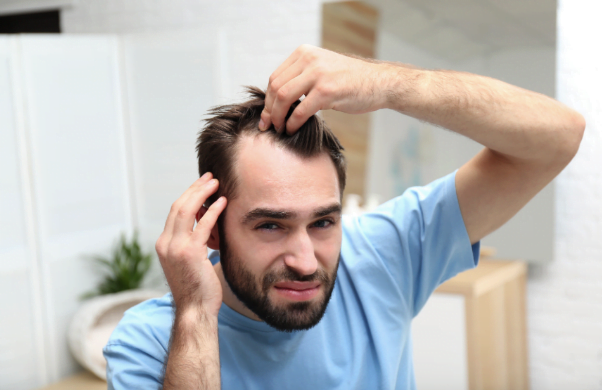We know that roughly 50% of men over the age of 50 will suffer from hair loss, but did you know that hair loss affects two-thirds of postmenopausal women?
The culprit behind this phenomenon is DHT. So what is DHT?
We’ll answer that question in this article and share ways that you can fight back against DHT hair loss.
What is DHT?
DHT stands for dihydrotestosterone and is an androgen, a sex hormone involved in the development of what is thought of as “male” sexual characteristics. It plays a part in androgenic alopecia, a type of hair loss that affects both men and women.
What Is the Function of DHT?
DHT, along with testosterone, are some of the hormones involved with sexual development. Some of the traits they play a role in developing include the growth of male genitalia, fat storage in your body, the deepening of the voice, and increased muscle mass and body hair.
While men typically have more testosterone, this hormone is present in both sexes. DHT is created from testosterone thanks to an enzyme called 5-alpha reductase (5-AR), and approximately 10% of the testosterone in adults gets converted to DHT.
Having Too Much
Unfortunately, excess levels of DHT do not only contribute to androgenic alopecia. High DHT levels contribute to coronary heart disease, slower skin healing post-injury, prostate enlargement, and prostate cancer.
Having Too Little
Just as having too much DHT can cause problems, so can having too little of this hormone. Low levels of DHT contribute to an increased risk of prostate tumors, fat distribution changes, and late or incomplete development of sexual organs. Other than the possible delayed onset of puberty, lower DHT levels do not show much of an effect on women.
DHT’s Connection to Hair Loss
So how does DHT contribute to hair loss? DHT plays a role in hair loss because it flows through the bloodstream and links to androgen receptors located on the hair follicles.
When high levels of DHT link to androgen receptors, it can cause the follicles to shrink, increase the amount of time it takes to grow new hairs, and shorten the hair growth cycle. Variations in the androgen receptor gene, such as an increase in receptivity, can cause some people to be more susceptible to DHT hair loss.
Reducing DHT
Some treatments demonstrate positive results in reducing and reversing DHT-related hair loss. The two main types of treatments are inhibitors and blockers. Inhibitors reduce your body’s natural production of DHT, and blockers prevent DHT binding to 5-AR receptors.
Let’s go over a few of the treatments you can use to reduce or reverse hair loss.
Minoxidil
Minoxidil is a peripheral vasodilator that is useful as a blood pressure medication. Minoxidil is usually applied topically to the scalp for hair loss and found in hair loss products such as Rogaine.
Finasteride
A prescription-only oral medication used for hair loss is Finasteride, also known as Propecia or Proscar. This medication binds to your 5-AR receptors to prevent DHT from doing so.
Biotin
Biotin is a B vitamin present in whole grains, nuts, and egg yolks but is also available as an oral supplement. Biotin has the ability to boost and maintain the body’s keratin levels, one of the main proteins found in your hair, skin, and nails.
Vitamins B-6 and B-12
B-6 and B-12 are also B vitamins that can contribute to hair thinning and loss if you have a deficiency in them. They improve blood flow to the scalp and can make your hair healthier and thicker. Because B vitamins play a role in the health of your hair, skin, and nails, taking a comprehensive B vitamin supplement is an essential step in reducing hair loss.
Are you curious about more ways to fight DHT hair loss? Click here for more information on ways you can fight DHT.
Reversing DHT Hair Loss for Women
As we’ve touched on, nutrient deficiencies can contribute to hair loss. This is especially true for women, where iron or protein deficiencies can be a factor in the loss of hair. Stress is also a major contributing factor for hair loss in women.
Due to hair loss being the result of hormonal imbalances, hormone-regulating supplements such as estrogen and progesterone can help fight androgenic alopecia in women.
DHT Blockers for Women
Pharmaceutical androgen receptor inhibitors should only be used if other hair loss treatment methods have not been effective. If pharmaceutical intervention is necessary, here are a couple of the medications recommended for women:
Cimetidine (Tagamet): used to treat hirsutism (excess facial hair growth) in women. Cimetidine is a histamine-blocker that shows the ability to block DHT from binding to androgenic receptors.
Spironolactone (Aldactone): typically used to treat hyperaldosteronism, reduces fluid levels in the body without potassium loss. Spironolactone slows the production of androgens and blocks DHT from binding to androgenic receptors.
Potential Side Effects of DHT Blockers
Because DHT blockers can have adverse side-effects, their use is only recommended as a last resort if other treatments have not been effective. If you choose to use DHT blockers, the side effects can include the following:
- Rash
- Tenderness and excess fat development in the breast area
- Nausea
- Vomiting
- Thickening and darkening of body hair
- Congestive heart failure due to salt and water retention
- Erectile dysfunction
Fighting DHT Hair Loss
Now that we’ve answered the question of “what is DHT” and demonstrated how it contributes to hair loss, you can be confident that reversing hair loss is possible.
Did we cover a hair loss treatment that you use? Share your methods for fighting hair loss in the comments below!

